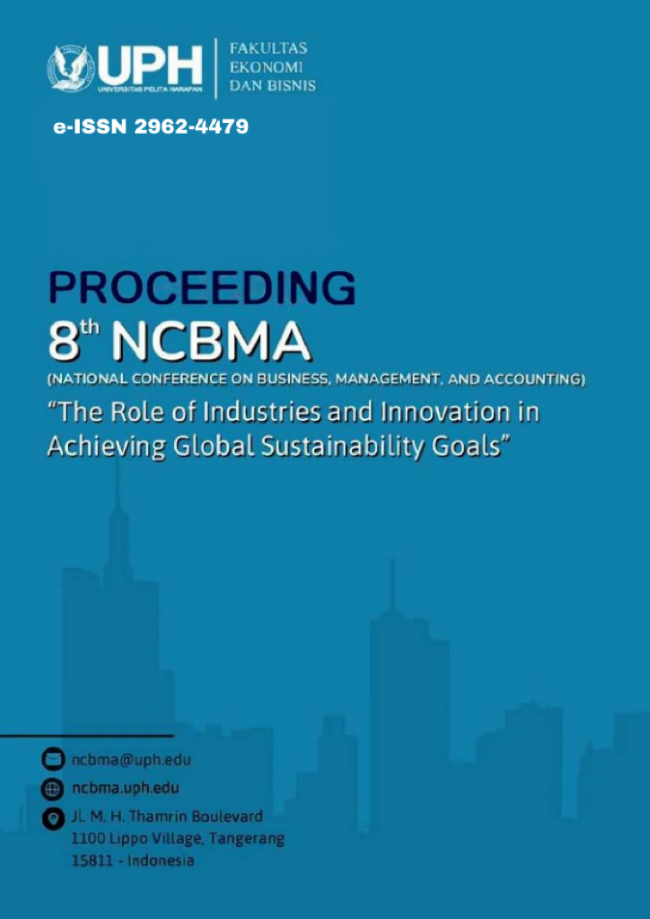THE INFLUENCE OF GROWTH OPPORTUNITY TOWARDS HEDGING DECISIONS WITH EARNINGS QUALITY AS A MODERATOR
Keywords:
Hedging Decisions, Growth Opportunity, Earnings Quality, Financial SectorAbstract
This research is conducted to analyze the influence of Growth Opportunity towards Hedging Decisions with Earnings Quality as the moderating variable in financial sector companies listed in the Indonesia Stock Exchange from 2019 to 2023, as the trend in hedging activities in Indonesia showed a contrasting belief to the Prospect Theory, in which the Indonesian companies hedged more when they might not be doing well in general during times of crisis. The independent variable used in this study is Growth Opportunity alongside 4 control variables. The dependent variable is Hedging Decisions and the moderator variable is Earnings Quality. The research used secondary data from financial sector companies listed in the IDX from 2019 to 2023 and the data source are S&P Capital IQ and Pro. By using the purposive sampling, 90 companies were eligible. The method Logistic Regression analysis is used and processed through SPSS version 25. The outcomes of the research indicate that both Growth Opportunity and Earnings-Quality-moderated Growth Opportunity have insignificant effect towards Hedging Decisions, implying that neither Growth Opportunity nor Earnings-Quality-moderated Growth Opportunity is a consideration for the accounting and management team of the Indonesian financial companies in deciding to carry out hedging activities during 2019-2023.
References
Ambarish, R., John, K., & Williams, J. (1987). Efficient Signalling with Dividends and Investments. The Journal of Finance, 42(2), 321. https://doi.org/10.2307/2328255
Brigham, E. F., & Houston, J. F. (2019). Fundamentals of Financial Management (15th ed.). Cengage.
deWaard, A. (2024). Derivative Media: How Wall Street Devours Culture. University of California Press. https://doi.org/10.1525/luminos.197
Dharmiyanti, N. M. D., & Darmayanti, N. P. A. (2020). The Influence of Liquidity, Growth Opportunities, and Firm Size on Non-Finance Companies’ Hedging Policy in Indonesia Stock Exchange. American Journal of Humanities and Social Sciences Research, 1, 129–135. www.ajhssr.com
Fajri, M. B., Putro, G. M. H., Bait, J. F., & Megasyara, I. (2023). What Factors Affect Hedging? Empirical Evidance from Indonesia. MEC-J (Management and Economics Journal), 7(1), 21–42. https://doi.org/10.18860/mec-j.v7i1.19277
Hartono, H., Pasoloran, O., & Daromes, F. E. (2020). Role of Hedging Mechanism in Maintaining Volatility Cash Flow and Growth Opportunity and Their Impact on Investor Reaction. Jurnal Ilmiah Akuntansi Dan Bisnis, 15(1), 23. https://doi.org/10.24843/jiab.2020.v15.i01.p03
Hetrina, D, D. P., & Suyanto. (2020). Analisis Faktor-faktor yang Mempengaruhi Keputusan Hedging dengan Kualitas Laba sebagai Moderasi pada Industri Manufaktur di Indonesia Tahun 2014-2017. Jurnal Riset Akuntansi Terpadu, 13(2), 157–172. https://doi.org/https://doi.org/10.35448/jrat.v13i2.8473
Jensen, M. C. (2002). Value Maximization, Stakeholder Theory, and the Corporate Objective Function. Business Ethics Quarterly, 12(2), 235–256. https://doi.org/10.2307/3857812
Kahneman, D., & Tversky, A. (1979). Prospect Theory: An Analysis of Decision Under Risk. Econometrica, 47(2), 263–291.
Kieso, D. E., Weygandt, J. J., & Warfield, T. D. (2019). Intermediate Accounting (17th ed.). Wiley.
Larasati, A. A., & Wijaya, E. (2022). Determinasi Faktor-faktor Keputusan Hedging dengan Instrumen Derivatif pada Perusahaan Manufaktur. Jurnal Bisnis Dan Manajemen, 9(2), 193–204. https://doi.org/10.26905/jbm.v9i2.8853
Marhaenis, L. G., & Artini, L. G. S. (2020). Pengaruh Financial Distress, Growth Opportunities dan Liquidity Terhadap Keputusan Hedging Pada Perusahaan Pertambangan BEI. E-Jurnal Manajemen Universitas Udayana, 9(5), 1778. https://doi.org/10.24843/ejmunud.2020.v09.i05.p07
Menicucci, E. (2020). Earnings quality: Definitions, measures, and financial reporting. In Earnings Quality: Definitions, Measures, and Financial Reporting. Palgrave Macmillan. https://doi.org/10.1007/978-3-030-36798-5
Modigliani, F., & Miller, M. H. (1958). The Cost of Capital, Corporation Finance and the Theory of Investment. The American Economic Review, XLVIII(3), 261–297.
Pangestuti, D. C., Fadila, A., & Nugraheni, S. (2020). Analisis Regresi Logistik : Faktor — Faktor Yang Mempengaruhi Keputusan Hedging Menggunakan Instrumen Derivatif. Jurnal ASET (Akuntansi Riset), 12(2), 227–240. https://doi.org/10.17509/jaset.v12i2.25420
Pilotte, E. (1992). Growth Opportunities and the Stock Price Response to New Financing. The Journal of Business, 65(3), 371–394. https://www.jstor.org/stable/2353271
Wahyudi, S., Goklas, F., Rita, M. R., Hersugondo, H., & Laksana, R. D. (2019). The Determinants of Corporate Hedging Policy: A Case Study from Indonesia The Determinants of Corporate Hedging Policy: A Case Study from Indonesia. International Journal of Economics and Business Administration, VII(1), 113–129. https://ijeba.com/issues/7/25
Downloads
Published
Issue
Section
License

This work is licensed under a Creative Commons Attribution-ShareAlike 4.0 International License.

